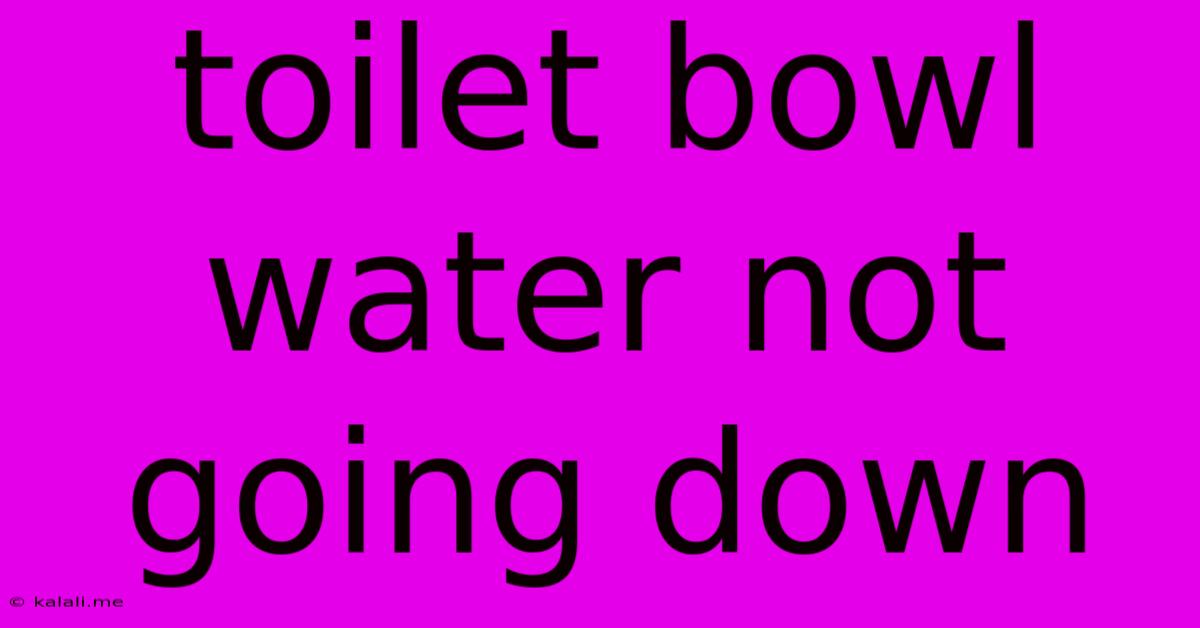Toilet Bowl Water Not Going Down
Kalali
May 23, 2025 · 4 min read

Table of Contents
Toilet Bowl Water Not Going Down: Troubleshooting and Solutions
A toilet that won't flush properly is a frustrating plumbing problem. Whether the water is slowly draining, completely stopped, or just not flushing effectively, understanding the underlying causes is crucial to finding a quick and effective solution. This guide will walk you through common reasons why your toilet bowl water isn't going down and how to fix them, saving you the cost and hassle of calling a plumber for minor issues.
Why is my toilet not flushing properly? This is a common problem with various causes, ranging from simple blockages to more complex plumbing issues. The key is to systematically investigate the potential culprits. Let's dive into the most frequent reasons:
1. Clogged Toilet: The Most Common Culprit
The most obvious reason for slow or stopped drainage is a clogged toilet. This is often caused by:
- Excessive toilet paper: Using too much toilet paper can easily overwhelm your plumbing system.
- Flushable wipes: Despite the label, many "flushable" wipes don't break down and can cause significant blockages.
- Other foreign objects: Accidentally flushing toys, sanitary products, or other non-biodegradable items are frequent causes of blockages.
Solution: The first step is usually to try a plunger. Ensure you have a good seal around the drain opening and plunge vigorously. If this doesn't work, you might need a toilet auger (also known as a plumber's snake) to reach and break up the blockage. For persistent problems, consider using a chemical drain cleaner, but always follow the manufacturer's instructions carefully and ensure proper ventilation.
2. Issues with the Flapper Valve
The flapper valve is a crucial component responsible for controlling water flow into the bowl. Problems with this valve can significantly impact flushing efficiency. Common issues include:
- A worn-out or damaged flapper: Over time, the flapper can become warped, cracked, or simply not seal properly, leading to a continuous trickle of water into the bowl or an incomplete flush.
- A misaligned flapper chain: If the chain connecting the handle to the flapper is too tight or too loose, it might prevent the flapper from sealing completely.
Solution: Check the flapper for any signs of wear and tear. If it's damaged, replace it. Adjusting the chain length can often resolve issues with improper sealing. A simple adjustment can often restore proper functionality without the need for costly repairs.
3. Low Water Level in the Tank
An insufficient water level in the tank means there's not enough water to effectively flush the toilet. This can result from:
- A faulty fill valve: The fill valve is responsible for refilling the tank after each flush. If it's malfunctioning, it might not fill the tank completely.
- A leaky fill valve: A constantly dripping fill valve could also lead to a lower-than-normal water level.
- A cracked or damaged tank: Cracks in the tank can cause slow leaks, gradually reducing the water level.
Solution: Inspect the fill valve for any signs of damage or leaks. If it's faulty, replace it. Check for cracks in the tank; if found, a repair kit might be sufficient or tank replacement may be necessary.
4. Clogged Drain Line
Sometimes, the problem isn't within the toilet itself, but further down the drain line. This usually manifests as slow drainage even after plunging.
Solution: This often requires a professional plumber to use specialized tools to clear the clog further down the line.
5. Other Potential Problems
While less common, other factors can contribute to flushing problems:
- Frozen pipes (in cold climates): Ice can block the drain line.
- Plumbing vent issues: A blocked vent can create pressure that prevents proper draining.
Prevention is Key:
To prevent future toilet problems, consider these tips:
- Avoid flushing inappropriate items: Stick to toilet paper and human waste.
- Regularly check the flapper valve: Early detection of issues can prevent major problems.
- Maintain proper water level in the tank: Address any leaks or fill valve issues promptly.
By systematically checking these potential problems, you can usually identify and solve the cause of your toilet's poor flushing performance, saving both time and money. However, for persistent or complex issues, it's always advisable to contact a qualified plumber.
Latest Posts
Latest Posts
-
Power Up Radio Transmitter Fallout 4
May 24, 2025
-
Getting Flowers 2 Days Before Giving Them
May 24, 2025
-
Pass Argument Ti A Function In Ksh
May 24, 2025
-
How Old Was Harry When His Parents Died
May 24, 2025
-
100 Amp Sub Panel Wiring Diagram
May 24, 2025
Related Post
Thank you for visiting our website which covers about Toilet Bowl Water Not Going Down . We hope the information provided has been useful to you. Feel free to contact us if you have any questions or need further assistance. See you next time and don't miss to bookmark.